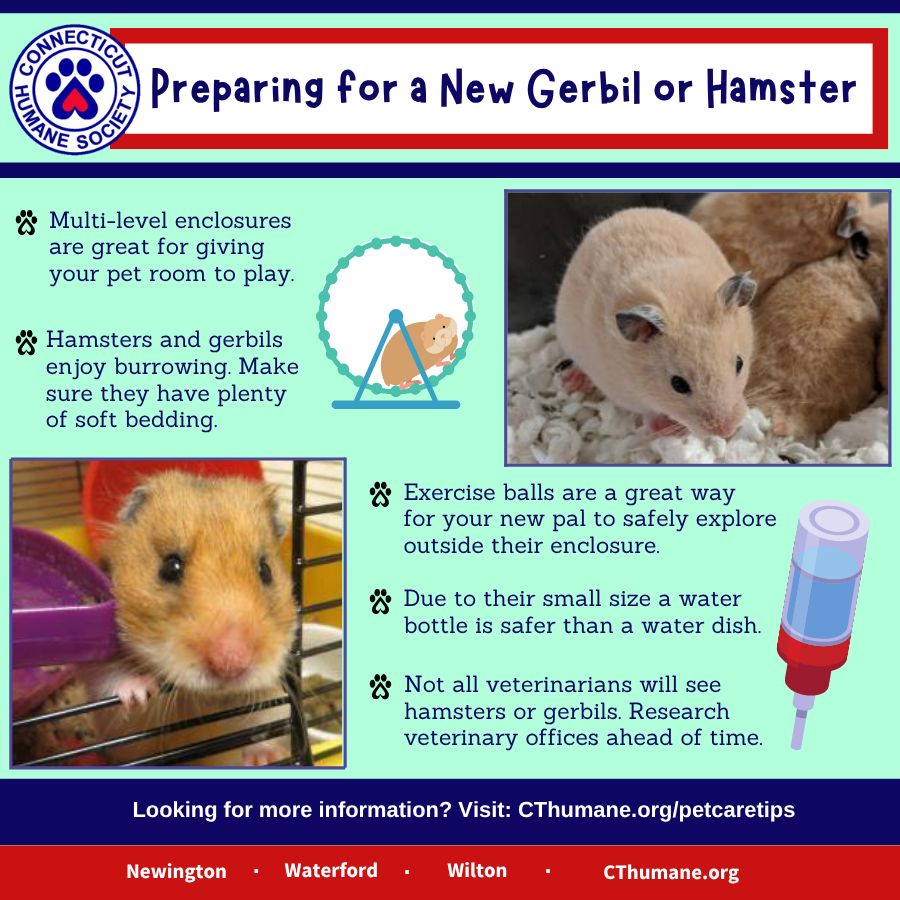
“What pet should I get?” It’s not just the title of a Dr. Suess book, it’s a question often heard from a first-time visitor to the Connecticut Humane Society. You’ve already thought about the pros and cons and whether or not you’re ready to get a pet, but you still might be on the fence about what type of pet you want. Or maybe you just adopted a pet, and you want to make sure you’ve covered all your bases. Check out these tips to start.
Basic Information
Average adult size: 4-5 inches long
Average life span:
- Hamsters: 2 to 3 years with proper care
- Gerbils: up to 5 years with proper care
Which is which?
- Hamsters have little stubs for tails and are nocturnal; they are active during the night and sleep during the day.
- Gerbils have tails and are a bit more active during the day burrowing and exploring, in comparison to the nocturnal hamster.
Always wash your hands after handling your pet or cleaning its dishes, cage, toys, etc.
Diet and Feeding
- Fresh food and water should always be available. Most hamsters and gerbils are accustomed to drinking from a water bottle.
- Specialized pellets or lab blocks should make up 90% of their diet, along with small amounts of fresh vegetables and fruits. Many hamsters are used to a seed-heavy diet. They should be transitioned gradually onto a pellet food.
- Vegetables and fruits not eaten within a few hours should be discarded.
- Clean, fresh, filtered, chlorine-free water, changed daily.
- Do not feed chocolate, caffeine or alcohol as these can cause serious medical conditions. Avoid sugar and high fat treats.
Housing
- Can I have more than one? Hamsters prefer to be in solitary housing – they prefer you as a friend instead of another hamster! If males and females are kept together, breeding or fighting may occur.
- Gerbils may be kept in same sex pairs. If males and females are kept together, breeding or fighting may occur.
- Both animals acclimate well to average household temperatures, not above 80°F. Avoid extreme temperature changes. The habitat should be placed off the floor in an area that is away from drafts and not in direct sunlight.
- A habitat should be plastic, metal, or glass with an escape-proof solid bottom. The larger the habitat, the better.
- 1-2” of paper bedding, such as Carefresh, is recommended. Cedar shavings should never be used as bedding.
- Clean and disinfect the habitat and non-porous toys regularly; remove wet spots daily and change bedding at least once a week or more often if necessary.
Training and Enrichment
- Gentle and rewards-based handling will help build and strengthen your bond with your new hamster/gerbil.
- Provide a variety of chewable toys to promote proper teeth wear, as rodents’ teeth grow continuously throughout their life.
Health and Veterinary Care
A healthy hamster/gerbil should be active (at night if it’s a hamster), alert, and sociable, eating and drinking often, with healthy fur and clear eyes. A pet who has discharge from the eyes or nose, is inactive, losing weight, has diarrhea, hair loss, or distressed breathing may be sick. See a veterinarian to help your little one get on the mend.
Keep in mind that gerbils require a weekly dust bath. The dust bath should be removed from the habitat after 15-30 minutes. Some gerbils may like being brushed with a soft brush.
Check out the video below for kid-friendly hamster care tips.
